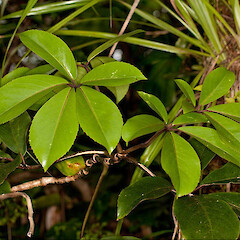Pseudopanax laetus
Synonyms
Panax arboreus var. laetus Kirk, Nothopanax laetus (Kirk) Cheeseman, Neopanax laetus (Kirk) Philipson
Family
Araliaceae
Flora category
Vascular – Native
Endemic taxon
Yes
Endemic genus
Yes
Endemic family
No
Structural class
Trees & Shrubs - Dicotyledons
NVS code
The National Vegetation Survey (NVS) Databank is a physical archive and electronic databank containing records of over 94,000 vegetation survey plots - including data from over 19,000 permanent plots. NVS maintains a standard set of species code abbreviations that correspond to standard scientific plant names from the Ngä Tipu o Aotearoa - New Zealand Plants database.
PSELAE
Chromosome number
2n = 48
Current conservation status
The conservation status of all known New Zealand vascular plant taxa at the rank of species and below were reassessed in 2017 using the New Zealand Threat Classification System (NZTCS) – more information about this can be found on the NZTCS website. This report includes a statistical summary and brief notes on changes since 2012 and replaces all previous NZTCS lists for vascular plants.
Please note, threat classifications are often suggested by authors when publications fall between NZTCS assessment periods – an interim threat classification status has not been assessed by the NZTCS panel.
- Conservation status of New Zealand indigenous vascular plants, 2017 . 2018. Peter J. de Lange, Jeremy R. Rolfe, John W. Barkla, Shannel P. Courtney, Paul D. Champion, Leon R. Perrie, Sarah M. Beadel, Kerry A. Ford, Ilse Breitwieser, Ines Schönberger, Rowan Hindmarsh-Walls, Peter B. Heenan and Kate Ladley. Department of Conservation. Source: NZTCS and licensed by DOC for reuse under the Creative Commons Attribution 4.0 International licence.
2017 | At Risk – Declining | Qualifiers: DP
Previous conservation statuses
2012 | Not Threatened
2009 | Not Threatened | Qualifiers: RF
2004 | Gradual Decline
Brief description
Bushy shrub with large hand-shaped leaves on red stalks
Distribution
Endemic. New Zealand: North Island (from Coromandel to inland Gisborne and Taranaki).
Habitat
Montane forest.
Detailed description
Small multi-branched tree to 5 m tall, branchlets brittle. Leaves alternate, leaflets 5–7, palmate, on short petiolules. Petiole to 25 cm long, sheathing branchlet at base, stipules present, purplish red. Petiolules stout, purplish red or leaflets subsessile. Leaflets obovate- to cuneate-oblong, thick and coriaceous, green above, paler below, margin coarsely dentate-serrate in distal half, acute or acuminate to subacute; midveins and main lateral veins obvious above and below; teminal lamina 12–25 × 5–10 cm or more, lateral leaflets smaller. Inflorescence a terminal, compound umbel, flowers sometimes subracemose on secondary rays; primary rays (branchlets) 10–15; 15–20 secondary rays. Calyx truncate or obscurely 5-toothed; petals ovate-oblong, acute. Ovary 2-loculed, each containing 1 ovules; style branches 2, spreading. Fruit fleshy, purple, c. 5 mm diameter, laterally compressed, style branches retained on an apical disc. Seeds 2 per fruit, broadly-ovate or oblong, wrinkled, 3.4–4.7–(5.1) mm long.
Similar taxa
The dark red petioles and large leaflets of this species are distinctive
Flowering
(August)–September–November
Fruiting
October–February
Propagation technique
Very easy from fresh seed. Can be grown from semi-hardwood cuttings. Very fast growing and tolerant of a wide range of soil types and moisture regimes but dislikes very dry soils. Best in damp soils.
Threats
This species is highly palatable to browsing animals. Subsequently it is usually only found in cliff refugia or other similar sites inaccessible to browsing animals. Possums seriously damage plants and have been responsible for its near extinction in some parts.
Etymology
pseudopanax: False cure
laetus: From the Latin laetus ‘bright’
Where To Buy
Common in cultivation and sold by most plant nurseries.
Notes on taxonomy
This species was transferred back to Neopanax Allan by: Frodin & Govaerts (2003).
Attribution
Description adapted from Allan (1961), Eagle (2006), Webb and Simpson (2001).
References and further reading
Allan HH. 1961. Flora of New Zealand, Volume I. Indigenous Tracheophyta: Psilopsida, Lycopsida, Filicopsida, Gymnospermae, Dicotyledones. Government Printer, Wellington, NZ. 1085 p.
Eagle A. 2006. Eagle’s complete trees and shrubs of New Zealand. Te Papa Press, Wellington, NZ. 2-volume boxed set: vol. 1 pp 1–529; vol. 2: pp 532–1114.
Frodin DG, Govaerts R. 2003. World Checklist and Bibliography of Araliaceae, The Cromwell Press, European Union. 444 p.
Webb CJ, Simpson MJA. 2001. Seeds of New Zealand Gymnosperms and Dicotyledons. Manuka Press, Christchurch. 428 p.











